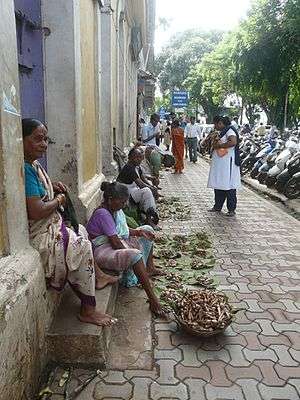Termitomyces
Termitomyces is a genus of basidiomycete fungi belonging to the family Lyophyllaceae. There are 30-40 species in the genus, all of which are completely dependent on termites to survive.[3] They are the food source for a subfamily of termites, the Macrotermitinae, who enjoy an obligate symbiosis with the genus similar to that between Atta ants and Attamyces mushrooms. Despite this relationship, spore transfer is still accomplished mainly by shedding from mushrooms, which protrude from the termite mounds.[4]
| Termitomyces | |
|---|---|
 | |
| Termitomyces reticulatus | |
| Scientific classification | |
| Kingdom: | Fungi |
| Division: | Basidiomycota |
| Class: | Agaricomycetes |
| Order: | Agaricales |
| Family: | Lyophyllaceae |
| Genus: | Termitomyces R.Heim, 1942[1] |
| Type species | |
| Termitomyces striatus (Beeli) R.Heim | |
| Synonyms[2] | |
|
1945 Podabrella Singer | |
Characteristics
These mushrooms are edible for most people, and the larger species are a popular wild food where they occur. They include the largest edible mushroom in the world, Termitomyces titanicus of West Africa and Zambia, whose cap reaches 1 metre (3.28ft) in diameter. These fungi grow on 'combs' which are formed from the termites' excreta, dominated by tough woody fragments. Termitomyces was described by Roger Heim in 1942.[5]
From 1955 to 1969 Arthur French [6] worked in Uganda (as a hobby) on the subject of fungi and termites. Some scientific literature about these fungal species existed previously, but these texts failed to adequately discuss the relationship between termites and their fungal symbiotes, while the various edible varieties were merely termed "termite mushrooms." French conducted some investigations with the help of the elderly Baganda women who gathered termite mushrooms, and published his findings.
Culinary use
This genus is a popular seasonal delicacy in the Indian state of Goa. For about two weeks at the beginning of August every year, clusters of villagers dot the Goan roadside hawking the handpicked mushrooms. A spicy gravy known as "Tonak" is a popular method of preparation. Since Termitomyces mushrooms are difficult to mass produce, they command a high price.[7]

Species
- Termitomyces aurantiacus
- Termitomyces bulborhizus
- Termitomyces clypeatus
- Termitomyces eurhizus
- Termitomyces globulus
- Termitomyces heimii
- Termitomyces le-testui
- Termitomyces mammiformis
- Termitomyces microcarpus
- Termitomyces reticulatus
- Termitomyces robustus
- Termitomyces sagittiformis
- Termitomyces schimperi
- Termitomyces striatus
- Termitomyces titanicus
- Termitomyces tylerianus
- Termitomyces umkowaan
Other termite-associating fungi that may be confused with Termitomyces
- Inedible fruiting bodies of the genus Podaxis, which may also grow from termitaria. Podaxis species can be easily distinguished from those of Termitomyces in that Podaxis fruiting bodies resemble a "stalked puffball," or an unopened shaggy mane, while those of Termitomyces resemble a stereotypical mushroom or toadstool.
- In China, fruiting bodies of the unrelated, but edible Macrolepiota albuminosa may also grow from termitaria. M. albuminosa was once incorrectly placed within this genus as "Termitomyces albuminosa".
References
- Kirk PM, Cannon PF, Minter DW, Stalpers JA (2008). Dictionary of the Fungi (10th ed.). Wallingford, UK: CABI. p. 682. ISBN 0-85199-826-7.
- "Termitomyces R. Heim 1942". MycoBank. International Mycological Association. Retrieved 2010-12-23.
- The Biggest Mushroom? — MykoWeb
- Mueller, U. G.; Gerardo, N. M.; Aanen, D. K.; Six, D. L.; Schultz, T. R. (2005). "The Evolution of Agriculture in Insects". Annual Review of Ecology, Evolution, and Systematics. 36: 563. doi:10.1146/annurev.ecolsys.36.102003.152626.
- Heim R. (1942). "Nouvelles études descriptives sur les agarics termitophiles d'Afrique tropicale". Archives du Muséum National d'Histoire Naturelle (in French). 18 (6): 107–66.
- French A. (1993). "The Mushroom-Growing Termites of Uganda". Petits Propos Culinaires (44): 35–41.
- http://blog.parrikar.com/2013/08/05/wild-mushrooms-of-goa/
See Tobias Frøslev's Termitomyces page And an academic review of the relationship in Patterns of interaction specificity of fungus-growing termites and Termitomyces symbionts in South Africa Aanenet DK al BMC Evol Biol. 2007; 7: 115.